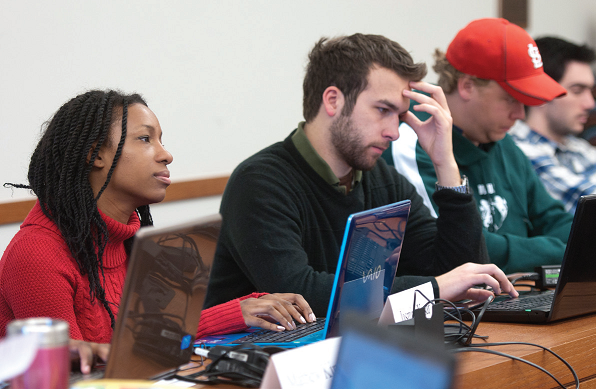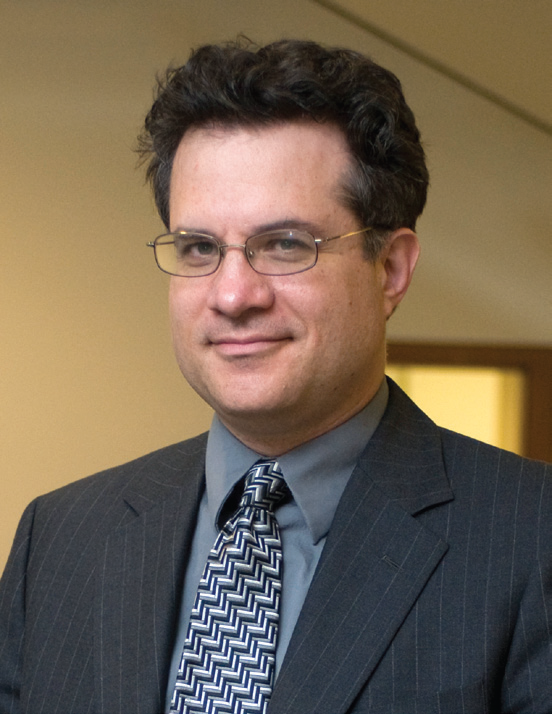BY ALANNA KLAPP
Universities are places where people from different backgrounds and viewpoints are constantly engaged in discussion. For that reason, free speech legal issues often arise. Additionally, the advent of the internet has opened up a new dimension of problems, among them academic freedom for faculty and students, freedom of association, and the blurring of the line between free speech and hate speech. These matters all impact diversity in positive and negative ways.

Students in the classroom at Washington University in St. Louis learn about topics such as free speech.
The internet on campus brings about technology-related free speech concerns. Registered Patent Attorney Steve Grant says the internet makes it easier to write hurtful words anonymously one wouldn’t otherwise say in person. Universities also have to be prudent about student usage of computer facilities and online resources for allocation purposes and content, such as questionable websites.
Another common free speech issue on campus concerns academic freedom among faculty and students. For example, a professor may take a controversial political or religious stand and be denied tenure. The professor then complains about the denial because of political or religious views. “In a sense that’s almost the basis of some free speech questions,” says Greg Magarian, professor of Law at Washington University in St. Louis. “Are we regulating what the people in the university community can do based on their ideas?” Universities have to be careful to uphold the First Amendment for both students and faculty who express their ideas, even if those ideas aren’t considered politically correct.
Freedom of association is another hot topic within the realm of free speech. If a chapter of the Christian Legal Society bans gay members and a public university responds by withholding sponsorship, does the university have an obligation to treat all student organizations the same way? This was the question posed to the Supreme Court in 2010 in the case of Christian Legal Society v. Martinez. The Court ruled in favor of the defendant, requiring university student groups to accept anyone from the student body as a member.
The line between free speech and hate speech is a more complicated matter. The term “hate speech” is not an actual legal term, rather it is a phrase used to talk about society. “I have a difficult time defining almost anything as hate speech,” says Grant. “If somebody can’t say something, they end up releasing that anger another way, like getting a gun. A lot of what’s said in a hate speech perspective shouldn’t be said if it’s not courteous speech, but it kind of goes back to ‘sticks and stones may break my bones but words will never hurt me.’ They are just words,” he adds.
There are some caveats that fall into the category of hate speech, such as “fighting words.” If one person walks up to another and starts to scream insults about that person’s race, gender, or family, and incites a forceful reaction, it is not protected by the First Amendment. “It’s sort of a tricky idea, but the underlying theory has something to do with the notion that we don’t want people to provoke violent confrontations,” says Magarian. “Maybe more of a serious and important category when it comes to the idea of hate speech is that the First Amendment doesn’t protect threats a reasonable person would believe to be serious.” In other words, speech that makes others fear for their safety can be restricted.
“I think that theory is pretty sound, the idea that nothing about the First Amendment is supposed to allow someone to intimidate someone else through language,” he adds. In other words, fighting words and threats are exceptions, but otherwise hateful speech can’t be regulated on campus without violating free expression.
How do the legalities of free speech in higher education affect diversity? “There are a few different angles on this,” Magarian says. “Universities, public universities in particular, which are bound by Constitutional protection, have to respect free speech, and they have to honor the First Amendment. Then it gets down to what kind of diversity we’re talking about, and what the mechanisms are for promoting diversity. Hopefully free speech protections promote diversity of ideas, and encourage students with a variety of perspectives to speak out and participate in campus life.”
Protections like speech codes can have an undermining impact on diversity if students become intimidated or disaffected.
“That’s a concern I think university administrators need to be aware of. If we allow speech that is critical or derisive of people’s identities, then it’s going to discourage those people from participating in discourse, discussion, and activities on campus,” he adds.
What can administrators do in these types of situations?
“I think universities, generally speaking, care about the bottom line, that everybody is involved, and everybody is citizens of the institution and actively engaged,” Magarian says. If free speech protections undercut diversity efforts, Magarian recommends university officials compensate by turning problems into teachable moments. “Have more discussion and dialogue around the problems of identifying critical speech,” he says. “Institutions can hit back against the speech they find offensive or counterproductive without punishing the speaker.”
Universities can organize opportunities for minority students to have outlets to function as groups as well as encouraging discourse and communication among different organizations. One of the most important things universities can do is make clear the institution’s commitment to diversity in everything they do and the way they function. Students and faculty are free to say and think what they want while knowing the institution supports diversity.









